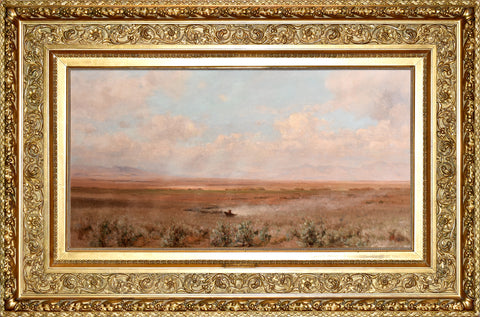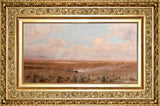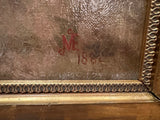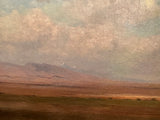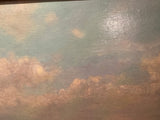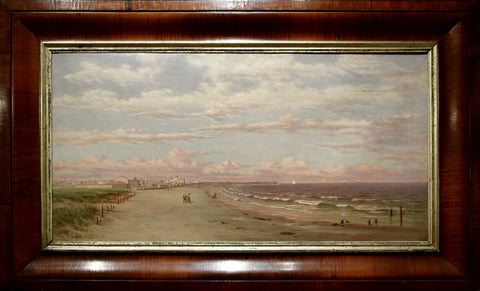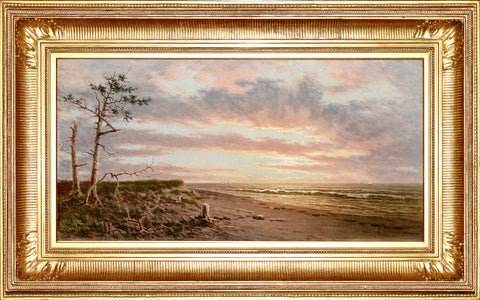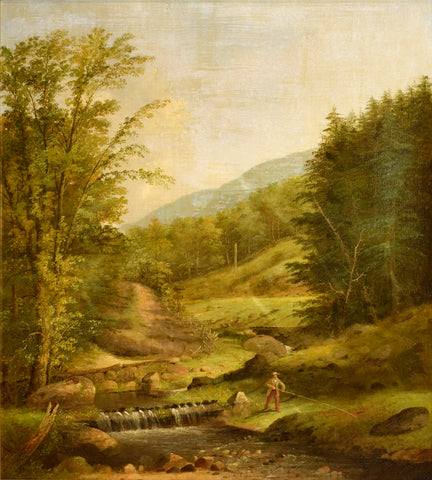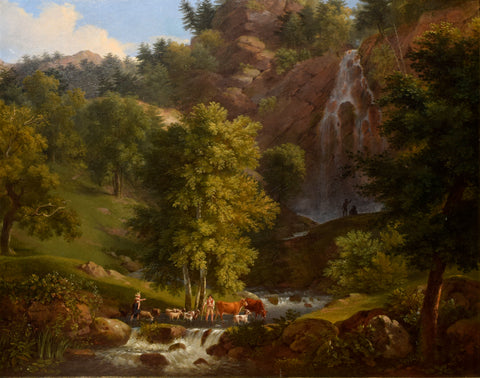Jervis McEntee (American 1828–1891), Valley of Humboldt
Jervis McEntee (American 1828–1891)
Valley of Humboldt
Oil on canvas
Signed in monogram ‘JME’ lower right and dated 1882
Canvas size: 17 3/4 x 34 5/16 in.
Hudson River School artist Jervis McEntee (1828–1891) is commonly known for his
moody landscapes and forest interiors. Much attention has been paid to his close
associations with other Hudson River School painters and the milieu of the storied
Tenth Street Studio Building. In turn, significant periods of his oeuvre have been
overlooked. Such is the case with the artist’s trip and subsequent canvases depicting
the American West. These undervalued works are ripe for new research and present a
rare opportunity for the discerning American art collector.
Jervis McEntee was born at Rondout (Kingston), New York, on July 14, 1829, to
parents of Irish-Huguenot ancestry. They named him for John Jervis, the famous chief
engineer of the Erie Canal, under whom his father had worked.
The McEntee home offered a traditional upbringing punctuated by encounters
with enigmatic figures that shaped Jervis’ life. As a boy, he learned about the arts and
poetry from a gifted boarder at his family home: poet Henry Pickering (1781–1838). He
introduced the young boy to fine art, poetry, and literature, profoundly impacting his life.
Jervis’ first formal artistic instruction was with Frederic Church in the winter of 1850-51;
the young artist was one of only two students who studied under this monumental
figure. They remained lifelong friends, even though they were opposites. Church was
outgoing, bombastic, and committed to the nationalistic ideology of Manifest Destiny.
Whereas McEntee was reflective with a poetic, emotional temperament. They shared a
unifying belief, as did other members of the Hudson River School, that an artist was an
interpreter of nature, and nature was a reflection of God. McEntee benefited from
Church’s technical mastery of the oil sketch recorded “en plein air” directly in the field
and then reworked in the studio—especially Church’s gift for conveying dramatic
atmospheric and light effects. McEntee never fully embraced his teacher’s fondness for
grand panoramas; he preferred quiet meditation on landscape.
hometown of Roundout (Kingston) and assisted on his parent’s farm. In 1854, he married Gertrude Sawyer and built a home on his parent’s property. From 1852 through 1890, the artist exhibited every year at the National Academy of Design. He was elected an Associate in 1860, a full Academician in 1861, and then took an active role in
Academy affairs.
McEntee and Church became charter tenants in Richard Morris Hunt’s Tenth
Street Studio Building in New York City in 1857. Every studio seems to have been
inhabited by a legendary artist, as Thomas Bailey Aldrich wrote in 1866:
… on the ground floor are the studios of Whittredge, Bradford, Dana, Beard,
Thompson the sculptor, Le Clear, Guy, and Bierstadt. The second floor is
occupied by Church, McEntee, Leutze, Hays, Hart, and Gignoux. Mr.
Tuckerman, the author, has a pleasant study and library on this floor. On the
third story are Gifford, Hubbard, Suydam, Shattuck, Thorndike, Haseltine, de
Haas, Brown, Casilear, and Martin. Here they are all together, — historical
figure, portrait, landscape, marine, animal, fruit, and flower painters.
Many of these men were either bachelors or commuters; McEntee was the only married
member of the “fraternity.” Jervis and Gertrude’s space became a salon within the
Studio Building. Their apartment was the only one that had a kitchenette, and a dinner
invitation was highly prized. In 1858, McEntee built a studio on the family farm, and the
couple began to split their time between the “summer studio” upstate and the “winter
studio” in New York City.
During the Civil War, McEntee joined his friend Sanford Gifford in volunteering for
the New York State Militia. In 1863, he and Gifford spent three months in Europe. In
1867, McEntee sent three works to the American section of the prestigious Paris
Exposition, the artist and his wife went to Europe in the summer of 1868 and remained
for about a year.
When Gertrude died on October 14, 1878, McEntee stayed on at the Studio, but
as a man prone to depression, life was increasingly difficult. The spring of 1881 was
particularly rough for McEntee. He painted but could only find fleeting joy in beautiful
“grand effects” after rainstorms. His sister Lucy, who lived with her husband near Fort
Halleck, Nevada, encouraged him to visit out west. After much back and forth, he wrote
in his diary on May 31, 1881, “A letter from Lucy hoping I will come. Wrote her I had
finally concluded to come if they send the passes.”
mountains. McEntee wrote that spring, “Have been thinking much today, as indeed I do
every day about dear Gertrude. I think my visit to the mountains and the places where
we used to stay has brought her very near me again… all the old places had a kind of
sacredness because she had been there with me.” (McEntee diaries, June 3, 1881). He
departed New York on June 29th 1881.
Jervis McEntee must have left his daily diary in New York because his summer
entries stop and pick up again in September. McEntee recorded nearly every day in the
years prior who he met, what he ate, his errands, and his art, which makes one think he
must have had another journal on his trip. Lacking a publicly available first-hand
account of his time there, we must rely on the piecemeal correspondence and his
entries upon his return.
Tuesday, September 13, 1881 Jamie and I returned this morning from our visit to Lucy at Fort Halleck Nev. The two past months have been among the most interesting in my whole experience. The ride over this vast stretch of country and particularly over the Pacific rail road was crowded with interest day by day and never wearied me. I made a number of sketches and have returned with a hopeful and happy feeling and with the robust health born of living most of the time in the open air. Just before we left on account of an Indian outbreak in Arizona Capt Carrs company of the 1st Cavalry stationed at Halleck, left for Arizona so that now Andrews is there in command with only his Co. There is no other lady at the fort besides Lucy except Mrs. Mayer, the post traders wife. I feel that hereafter I should like to spend my summers some where in the great West. Since I went away Capt. David Abbey has died also Gus Hasbrouck and Col. Snyder. I unpacked my trunks and sketches, and showed my sketches to the family who seemed greatly interested.
Jervis McEntee returned from his three-month trip to Nevada with sketches of the
untouched landscape. Upon returning to his studio, he completed several atmospheric
compositions, including the present canvas depicting the sprawling Humboldt Valley.
“The landscape is very fine and the mountains as picturesque as possible. Great
sweeps of distance dotted with herds of cattle and terminating in Snow mountains are
characteristic of the region,” wrote McEntee. The present canvas of the Humboldt Valley
explores the sprawl and diversity of this American western locale. The artist was
captivated by the atmospheric effects of light and temperature to which much of the
canvas is dedicated. The panoramic format depicts the vastness of the Nevada
landscape. The dotting of green vegetation in the foreground is contrasted by the
claystone land and framed at the back by the mountain range, iced with the hint of a
snowcap and only interrupted by the touch of dust kicked up by a horse and rider
dwarfed by the seeming limitless West. The location appears to be present-day Starr
Valley, east of the Humboldt range.
The artist started this composition in his studio in the winter of 1882, writing:
“Wednesday, February 1, 1882 In the afternoon I began a Nevada picture from my
study in Star Valley and am greatly interested in it” and “Monday, February 6, 1882 …I
have improved my Humboldt Valley and hope to make a good picture.” After a few false
starts, “Friday, February 10, 1882 Painted my Humboldt Valley over. It does not please
me,” and “Saturday, February 11, 1882 Painted on my Humboldt picture but it does not
suit me,” he finalized his intended composition, “Wednesday, February 22, 1882
Painted on my Humboldt picture changing the foreground and greatly improved it. My
frame came and the picture looks very well in it and I feel more encouraged about it. “
Finishing it and stating, “Friday, February 24, 1882 Cold again. Have finished my picture
and improved it by putting a figure on horseback near the foreground.” This last entry
regarding the painting’s progress adds much to our understanding of his working
method. He began with the mountainous landscape and light effects, perhaps drawing
inspiration from his happy memories in the mountains with Gertrude, and then added
the figure last.
March 9, 1882 A rainy day. I am greatly depressed and cannot paint. My two pictures
went to the Academy, “Indian Summer”, and “The Humboldt Valley”.” “Friday, March
24, 1882 … Both of my pictures are hung in the North room the Indian Summer by the
door entering the East room and the Humboldt Valley on the same side of the room
near the entrance from the corridor.” And set a price, “Monday, Mar 27, 1882...
Concluded to insert the prices of my pictures in the next edition of the Catalogue. I put
the Indian Summer at $1250 with instructions to Brown to sell it for $1000 and the
Humboldt at $800 with a margin down to $600.” At what price the painting eventually
traded, we do not know.
McEntee’s Valley of Humboldt is among just a handful of examples from the
artist’s experimental period here. The artist moved beyond his characteristically austere
autumnal landscapes to explore sublime topography and more vivid colors that came to
define the promise of the American West.
Today, McEntee’s works are in the collections of the Metropolitan Museum of Art,
the Brooklyn Museum, the National Gallery of Art, Washington D.C., and the Cleveland
Museum of Art, among others.
We Also Recommend

